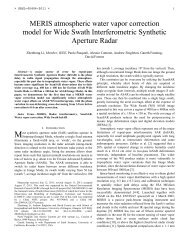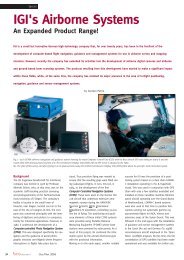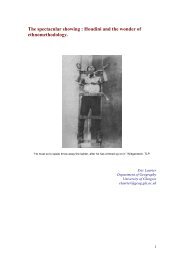Mobile Mapping Systems - University of Glasgow
Mobile Mapping Systems - University of Glasgow
Mobile Mapping Systems - University of Glasgow
Create successful ePaper yourself
Turn your PDF publications into a flip-book with our unique Google optimized e-Paper software.
Flickr Web site. However no mapping company or organisation has as<br />
yet admitted to its use <strong>of</strong> these systems, despite their obvious potential<br />
for 3D mapping and terrain modelling applications. Currently an<br />
HDL-64E Lidar is being used in conjunction with a multiple video camera<br />
system by the Real Time Race company from the U.K. to acquire<br />
the elevation and image data that is needed to form detailed 3D digital<br />
terrain models <strong>of</strong> Formula One race courses. These models will be<br />
used both for video games and during the live TV coverage <strong>of</strong> actual<br />
races.<br />
Positioning (Geo-referencing) Devices<br />
A dual-frequency survey- or geodetic-grade GPS or GNSS receiver<br />
remains the primary device that is used in mobile mapping systems<br />
for the determination <strong>of</strong> the absolute position <strong>of</strong> the moving vehicle<br />
and its imaging (camera) and ranging (laser scanner) devices. There<br />
are a large number <strong>of</strong> suitable GPS/GNSS receivers available from<br />
Trimble, Topcon, Leica, NovAtel, Javad, etc. that can generate the survey-quality<br />
positional data that is required. Invariably the GPS or GNSS<br />
receiver will be operated in differential mode relative to a suitable local<br />
base station or using a global DGPS service such as OmniSTAR. Indeed<br />
solutions based on such global services or on national monitoring networks<br />
(such as CORS) are largely replacing the use <strong>of</strong> local base stations.<br />
A number <strong>of</strong> mobile mapping systems feature a second GPS<br />
receiver with its antenna placed at a known distance (or base line)<br />
from that <strong>of</strong> the primary GPS receiver. The difference in position that<br />
this secondary receiver gives with respect to the primary receiver using<br />
the carrier phase observations from both receivers gives a very accurate<br />
measurement <strong>of</strong> the vehicle’s heading, even when the vehicle’s<br />
dynamics are low. However, since so much mobile mapping takes place<br />
within urban areas with tall (high-rise) buildings or in areas with dense<br />
tree canopies – where observation <strong>of</strong> the GPS or GNSS satellites may<br />
be restricted (giving rise to a weak geometry) or completely lost – the<br />
use <strong>of</strong> an inertial measurement unit (IMU) and an odometer (or distance<br />
measuring instrument) to provide additional positional information<br />
in these situations is almost standard.<br />
There are a large number <strong>of</strong> IMU devices that can generate a continuous<br />
stream <strong>of</strong> position and orientation data when the GPS or GNSS<br />
satellite signals are unavailable. However confining the present discussion<br />
to those that are most used in mobile mapping systems, three<br />
main types can be identified. (i) Those that use ring laser gyros (RLG)<br />
are the most accurate type. However they are expensive to manufacture,<br />
so their use is confined to those applications that demand the<br />
very highest accuracy. (ii) Fibre Optic Gyros (FOG) employing long<br />
coiled optical fibres as an alternative to the optical blocks or rings <strong>of</strong><br />
the RLG give a very acceptable accuracy and, since they are less expensive,<br />
they are widely used in the current types <strong>of</strong> IMU utilized in mobile<br />
mapping. (iii) Those gyros that are based on Micro Electro-<br />
Mechanical <strong>Systems</strong> (MEMS) technology utilize tiny quartz tuning<br />
forks as sensors that are integrated on to silicon chips. They are the<br />
least expensive type. While they are also the least accurate, they are<br />
still sufficiently accurate for many purposes. So they are coming into<br />
more widespread use in mobile mapping applications. Two <strong>of</strong> the best<br />
known system integrators <strong>of</strong> the IMUs that are used in mobile mapping<br />
systems are (i) Applanix, which is a Trimble company based in<br />
the Toronto area in Ontario, Canada and produces its widely used POS<br />
LV sub-system [Fig. 11]; and (ii) IGI from Kreustal in Germany which produces<br />
its TERRAcontrol sub-system. The Applanix POS LV systems use<br />
either MEMS gyros (in Models 220 and 420) or RLG gyros (in the Model<br />
610), while the IGI TERRAcontrol uses FOG gyros. Other suppliers include<br />
Crossbow, located in San Jose, California, which supplies GPS-aided<br />
inertial systems mainly based on MEMS technology; iMAR, based in<br />
RIEGL<br />
Laser Scanners for airborne, terrestrial,<br />
mobile & industrial applications<br />
Innovation in 3D<br />
RIEGL VMX-250<br />
www.riegl.com<br />
Features<br />
• two RIEGL VQ-250<br />
scanners with echo<br />
digitization integrated<br />
RIEGL<br />
LASER MEASUREMENT SYSTEMS<br />
RIEGL LMS GmbH, A-3580 Horn, Austria, <strong>of</strong>fice@riegl.co.at<br />
RIEGL USA Inc., Orlando, Florida, info@rieglusa.com<br />
RIEGL Japan Ltd., Tokyo, Japan, info@riegl-japan.co.jp<br />
• measurement rates up to<br />
2 x 300 000 meas./sec<br />
• scanning rates up to<br />
2 x 100 rotations/sec<br />
• eyesafe operation @<br />
laser class 1<br />
• compact and lightweight<br />
platform design<br />
• user-friendly mounting<br />
and installation<br />
Latest News? Visit www.geoinformatics.com January/February 2010<br />
37
















